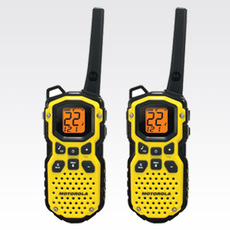 Earlier this year we gave you the inside scoop on a brand new Talkabout radio due this summer from Motorola. Well, the wait is over. The Motorola MS350R is here!
Earlier this year we gave you the inside scoop on a brand new Talkabout radio due this summer from Motorola. Well, the wait is over. The Motorola MS350R is here!
The Motorola MS350R is a powerful, high performance FRS/GMRS radio packed with all the features typical of a Talkabout model - with the ruggedness and durability of a Motorola business class radio to boot.
The MS350R offers 7 FRS, 8 GMRS and 7 shared FRS/GMRS channels, plus 8 repeater channels and 121 privacy codes. The fact that the MS350R is repeater capable makes it a great choice for outdoor activities, as it allows you to extend its potential reach beyond the normal range of a typical consumer radio.
The Motorola MS350R is also a waterproof radio. It meets IP-67/JIS-7 specifications for water resistance. The MS350R is also fully submersible in up to one meter of water for 30 minutes! Not that it would stay submersed very long anyway, since this Motorola radio also floats!
Of course, a radio that can be used in poor weather conditions and can survive a dunk in the water does you no good if you can't see it. So, Motorola also designed the MS350R with a bright yellow face so you can find it if you do happen to drop it in the drink. The MS350R is also ergonomically styled for an easier grip to help prevent you from dropping it in the first place. The MS350R also sports a loop at the top of the radio for attaching a lanyard for an added layer of security should the radio slip from your hand anyway.
The MS350R can also operate on either its rechargeable NiMH battery pack or three AA Alkaline batteries, providing dual power options to further energize its overall versatility. Other handy features, such as 11 Weather Channels), iVox functionality, ten Call Tones, Motorola's VibraCall® vibrating alert, Quiet Talk filter, and a built-in LED flashlight make this radio a perfect companion for your next hiking, camping or hunting trip into the Great Outdoors.
Due to its thicker shell, the MH350R is a bit larger than other Motorola Talkabouts, so it won't quite fit in a standard Talkabout drop-in charger base. Not to worry. A dual drop-in desktop charger is included with the package.
The MS350R is available now and Buy Two Way Radios has it in stock and ready to ship per your order. The complete MS350R package includes two radios, two belt clips, two NiMH battery packs, a two pocket drop in charger, an Emergency Preparedness Checklist Sheet and owner's manual.






